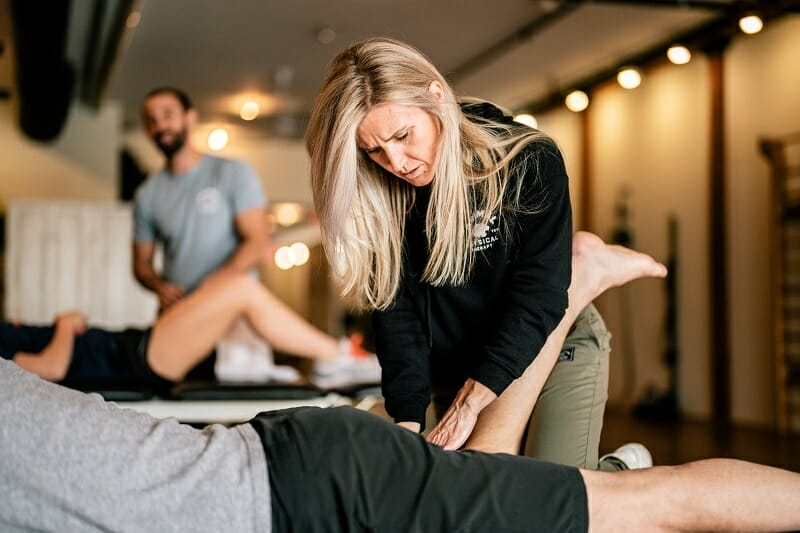Running is a great way to stay active and healthy, but it can also take a toll on your body, especially if you have poor running form. It’s a unique activity in which you may not know you’re doing something wrong until it’s too late. When shooting a basketball, there is immediate feedback that you’ve done something wrong if you miss. With running, you may not know you’re doing something wrong until you’re experiencing pain. Whether you’re a beginner or an experienced runner, a running gait analysis can help you become a better runner.
This article will explore the importance of running gait analysis, what it is, how it works, and who performs it.
What is Running Gait Analysis?

Running gait analysis evaluates how you run to identify any inefficiencies or issues in your technique.
By examining your running form, a professional can identify any factors limiting your performance or increasing your risk of injury.
How Does Running Gait Analysis Work?
The process of running mechanics and gait analysis can vary depending on the type of analysis. However, the basic steps involve evaluating your posture, stride, and foot strike.
In some cases, this can be done with the naked eye, while other methods involve technology such as video analysis or pressure plates.
Understanding Pronation: How It Affects Your Running Form
Pronation describes the inward rolling motion of the foot as it strikes the ground during running or walking. This motion is a normal part of the running gait cycle, but overpronation or underpronation can lead to issues with running form and increase the risk of injury.
- Overpronation occurs when the foot rolls inwards excessively, placing additional stress up the entire chain. This can lead to issues such as, but not limited to, shin splints, plantar fasciitis, and knee pain.
- Underpronation, or supination, occurs when the foot rolls outward, leading to reduced shock absorption and increased risk of unhealthy loading patterns.
Gait analysis can help identify issues with pronation and guide recommendations for corrective measures. These may include exercises to strengthen the foot,ankle and hip muscles, footwear recommendation, or form changes to improve how your body manages ground reaction forces.
By addressing issues with pronation, runners can improve their running form and reduce the risk of injury.
2D and 3D Running Gait Analysis
Your running gait can be assessed in a few ways. The naked eye, 2D motion caption with slow-motion on a high definition camera and 3D motion caption with sensors.
Video analysis involves recording a video of you running and then examining it to identify any inefficiencies or issues in your running form.
By watching your running form in slow motion, Gait experts like Dr. Eric Abramowitz, can identify factors that may be limiting your performance or increasing your risk of injury, such as:
- Overpronation or supination of the foot
- Improper spine angles, such as leaning too far forward or too upright.
- Inefficient stride length or cadence
- rear-foot / heel strike pattern
- Unnecessary upper body movement, such as excessive swing phase
- Muscle imbalances or weaknesses
- Lack of core stability
- Tightness or limited range of motion in specific joints
- Ineffective breathing patterns
Why Do Runners Benefit from Gait Analysis?

Running gait analysis can be a powerful tool for runners of all skill levels, helping to improve running form, prevent injuries, and enhance overall performance.
The Importance of Proper Running Form
Improving your running form can have a wide range of benefits for both experienced and novice runners. Some of these benefits include:
- Reduces the risk of injury: Proper running form can help prevent injuries such as shin splints, stress fractures, and a runner’s knee.
- Improves running efficiency: Good running form can help you use less energy while running, allowing you to run faster and longer.
- Enhances overall performance: By improving your running form, you can run with less effort, leading to improved speed and endurance.
- Corrects muscle imbalances: Good running form can help correct muscle imbalances and reduce the risk of overuse injuries.
- Increases body awareness: Gait analysis can help you become more aware of your body and how it moves while running, leading to better overall body mechanics.
How Gait Analysis Can Identify and Correct Issues in Your Running Form
A running gait analysis provides valuable information on specific problem areas and offers guidance on corrective exercises to prevent future injuries and improve running efficiency.
- Pinpoint problem areas: Gait analysis can help identify specific areas of your running form that may be causing issues, such as a your strike pattern, pelvic alignment or poor posture.
- Provide guidance on corrective exercises: Once problem areas are identified, gait analysis can guide specific exercises or techniques to correct them.
- Help prevent future injuries: By identifying and correcting issues in your running form, gait analysis can help prevent future injuries and improve overall performance.
- Improve running efficiency: By addressing issues in your running form, gait analysis can help improve running efficiency, allowing you to run faster and longer with less effort.
- Offer customized recommendations: Every runner is unique, and gait analysis can offer personalized recommendations based on your specific running form and goals.
Who Performs a Gait Analysis?

These are types of professionals who can perform gait analysis and provide recommendations to improve running form and prevent injuries:
- Physical therapists: Physical therapists are experts in human movement and can perform a gait analysis to identify running form issues that may contribute to injury or limit performance. They can also offer advice on corrective exercises to address these issues and prevent future injury.
- Podiatrists: Podiatrists specialize in the foot and ankle and can perform a gait analysis to identify any issues related to foot or ankle function. They can also give their professional recommendations on orthotics or other devices to correct issues with foot strikes.
- Biomechanists: Biomechanists are experts in the mechanics of human movement and can perform a detailed analysis of running form using technology such as motion capture systems. They can provide detailed data on factors such as joint angles and muscle activity.
Maximizing Your Running Potential: Improving Your Running Form with Gait Analysis

Once you’ve undergone a gait analysis, use the findings to identify areas that need improvement and develop a plan to address them.
Here are some key areas to focus on when assessing your gait and using gait analysis to improve your running form:
- Foot Strike: Foot strike refers to how your foot lands on the ground when running. This can affect your running efficiency and injury risk. Gait analysis can help identify whether you have a heel strike, midfoot strike, or forefoot strike and offer guidance on adjusting your form if necessary.
- Stride Length: Stride length refers to the size of each step you take while running. Gait analysis can help identify whether your running stride is too short or too long and offer guidance on adjusting it for optimal performance.
- Cadence: Cadence refers to the number of steps you take per minute while running. Gait analysis can help identify whether your cadence is too slow or too fast.
- Posture: Proper posture is crucial for good running form. Gait analysis can help identify any issues with your posture while running, such as hunching over or leaning too far forward, and offer guidance on correcting it.
Recommended Exercises and Training Programs

By incorporating these exercises and training programs into your running plan, you can improve your running form and maximize your performance. It’s essential to work with a qualified coach or physical therapist to develop a plan that’s tailored to your specific needs and goals:
Strength Training
Strength training is essential to any running program, as it helps build muscle and improve overall body mechanics. You can improve your running form and prevent injury by incorporating exercises that target specific muscle groups, such as the glutes and core.
Plyometrics
Plyometrics are explosive exercises that can help improve running economy and power. You can improve your stride length and cadence by incorporating exercises such as jump squats, box jumps, and bounding into your training program.
Form Drills
Form drills are specific exercises designed to improve running form. You can improve your foot strike, stride length, and cadence by practicing high knees, butt kicks, and skipping drills.
Interval Training
Interval training involves alternating periods of high-intensity exercise with periods of rest or lower-intensity exercise. By incorporating interval training into your running program, you can improve your running economy and speed.
Tips for Maintaining Good Running Form and Minimizing Injury Risk

Remember that good running form is a journey, not a destination, and that ongoing attention and effort are necessary to maintain optimal performance and minimize your risk of injury. Here are some tips for sustaining good running form:
- Focus on form: Continue maintaining proper running form during every run. Doing so can help reinforce good habits and prevent backsliding.
- Gradual progression: When increasing mileage or intensity, do so gradually to avoid overloading your body and increasing your risk of injury.
- Recovery: Proper recovery is crucial for preventing injury and maintaining good form. Make sure to incorporate rest days into your training program and prioritize recovery activities such as stretching, foam rolling, and massage.
- Cross-training: Incorporating cross-training activities such as swimming, cycling, or yoga into your training program can help prevent injury and improve overall fitness.
- Running shoes: Wearing the right running shoe for your foot type and running style is vital for maintaining good running form and minimizing injury risk. Consider working with a running specialist or physical therapist to select the right shoes for you.
Maximize Your Running Potential
In conclusion, running gait analysis is an important tool for runners of all skill levels. By examining your running form, a professional can identify any factors limiting your performance or increasing your risk of injury. Running gait analysis can help identify specific problem areas, provide guidance on corrective exercises, prevent future injuries, and improve overall performance. Good running form can be maintained with ongoing attention and effort to prevent backsliding and ensure optimal performance.